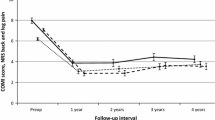Abstract.
Various forms of lumbar instability require a surgical stabilization. As an alternative to fusion, a mobile, dynamic stabilization restricting segmental motion would be advantageous in various indications, allowing greater physiological function and reducing the inherent disadvantages of rigid instrumentation and fusion. The dynamic neutralization system for the spine (Dynesys) is a pedicle screw system for mobile stabilization, consisting of titanium alloy screws connected by an elastic synthetic compound, controlling motion in any plane (non-fusion system). This prospective, multi-center study evaluated the safety and efficacy of Dynesys in the treatment of lumbar instability conditions, evaluating pre- and post-operative pain, function, and radiological data on a consecutive series of 83 patients. Indications consisted of unstable segmental conditions, mainly combined with spinal stenosis (60.2%) and with degenerative discopathy (24.1%), in some cases with disc herniation (8.4%), and with revision surgery (6.0%). Thirty-nine patients additionally had degenerative spondylolisthesis, and 30 patients had undergone previous lumbar surgery. In 56 patients instrumentation was combined with direct decompression. The mean age at operation was 58.2 (range 26.8–85.3) years; the mean follow-up time was 38.1 months (range 11.2–79.1 months). There were nine complications unrelated to the implant, and one due to a screw malplacement. Four of them required an early surgical reintervention. Additional lumbar surgery in the follow-up period included: implant removal and conversion into spinal fusion with rigid instrumentation for persisting pain in three cases, laminectomy of an index segment in one case and screw removal due to loosening in one case. In seven cases, radiological signs of screw loosening were observed. In seven cases, adjacent segment degeneration necessitated further surgery. Mean pain and function scores improved significantly from baseline to follow-up, as follows: back pain scale from 7.4 to 3.1, leg pain scale from 6.9 to 2.4, and Oswestry Disability Index from 55.4% to 22.9%. These study results compare well with those obtained by conventional procedures; in addition to which, mobile stabilization is less invasive than fusion. Long-term screw fixation is dependent on correct screw dimension and proper screw positioning. The natural course of polysegmental disease in some cases necessitates further surgery as the disease progresses. Dynamic neutralization proved to be a safe and effective alternative in the treatment of unstable lumbar conditions.
Similar content being viewed by others
Author information
Authors and Affiliations
Additional information
Electronic Publication
Rights and permissions
About this article
Cite this article
Stoll, T.M., Dubois, G. & Schwarzenbach, O. The dynamic neutralization system for the spine: a multi-center study of a novel non-fusion system. Eur Spine J 11 (Suppl 2), S170–S178 (2002). https://doi.org/10.1007/s00586-002-0438-2
Received:
Accepted:
Issue Date:
DOI: https://doi.org/10.1007/s00586-002-0438-2




